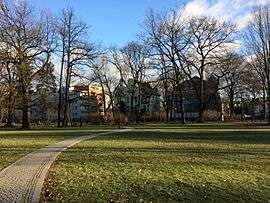Jan Kochanowski Park in Bydgoszcz
| Jan Kochanowski Park | |
|---|---|
| Polish: Park Jana Kochanowskiego w Bydgoszczy | |
|
Jan Kochanowski Park | |
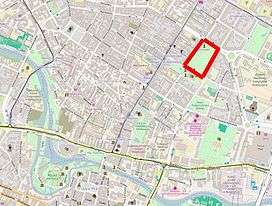 | |
| Location | Bydgoszcz, Poland |
| Coordinates | 53°07′47″N 18°00′42″E / 53.12972°N 18.01167°ECoordinates: 53°07′47″N 18°00′42″E / 53.12972°N 18.01167°E |
| Area | 3.15 hectares (31,500 m2) |
| Elevation | 50 metres (160 ft) |
| Created | 1901 |
| Designer | Konrad Neumann |
| Owned by | City of Bydgoszcz |
Jan Kochanowski Park is a green area covering 3,15 ha, located in downtown Bydgoszcz, Poland. It is part part of the so-called "Music district in Bydgoszcz" (Polish: Dzielnica muzyczna w Bydgoszczy).
Location
The park is located in an area urbanized at the beginning of the 20th century. The park is rectangular, with dimensions 120 × 250 m, and is delineated by the following avenues:
- January 20, 1920 street;
- Adam Mickiewicz Alley;
- Ignacego Paderewskiego street;
- Słowackiego street.
Due to the proximity of several musical institutions (Pomeranian Philharmonic, Polish Theatre in Bydgoszcz, Bydgoszcz Music Academy, Music Schools Group), as well as the outdoor gallery of monuments of composers and virtuoso, the park and its surroundings are called Music district in Bydgoszcz.
History
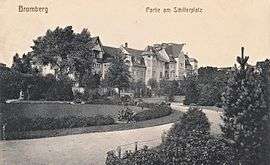
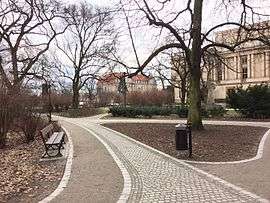
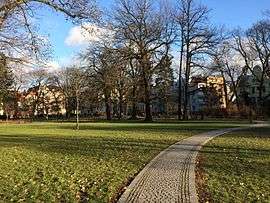
The park has been designed by Konrad Neumann, then director of the Municipal gardens of Bromberg in 1901; its initial surface was 2.8 hectares (28,000 m2). It was part of urban plans laid out in 1903, and developed through 1911[1] The design was inspired from English gardens, with about 80 species of trees and ornamental trees, mainly endemical native species.[2] The main entrance was located at Bismark Platz, today at the junction between Słowackiego and January 20, 1920 streets. The northern edge on Bulöw Straße (Adam Mickiewicz Alley) was a lawn planted with roses and low shrubs.[1]
In January 1920, Bydgoszcz joined the re-created state of Poland. On July 31, 1927, a ceremony unveiled in the park the monument to Henryk Sienkiewicz, first of its kind in the country.
In 1938, a survey in registered 84 species of trees and shrubs including:[1] white birch, common hawthorn, alders, sweet chestnuts, silver berry, common salt trees, walnut trees, magnolias, jasmines, poplars, silver poplars, cherry trees, English oaks, robinias, sumacs, elder berries, willows, lime trees, elms, basalm trees, firs, white firs, sawara cypresses, Norway spruces, blue spruces, mountain pines, pine trees, Swiss pines, English yews, ashleaf maples, ailanthus, sycamores, Norway maples, field maples, silver maples, horse-chestnuts, horse-chestnuts, beeches, European beeches, hornbeams and European hornbeams.
In particular, the park boasted elms and poplars 25 meters tall high and oaks with 300 to 480 cm circumference trunks.[1]
After World War II and the destruction of part of the trees, new plantings have been carried out in the post-war years. In 1952, during the construction of the Pomeranian Philharmonic hall, four 400 cm-perimeter oaks were cut down.[1] In 1958, the southern limit of the park has been extended to include the area of the Philharmonic. In 1960, in the northern part of the park, the statue The Archer, one of Bydgoszcz icons, was installed to a dedicated rectangular square.
In 2014, an overhaul of Jan Kochanowski Park has been performed, to highlight its historical character and link it with the Music District.[3] This works included:[4]
- Removing asphalt alleys from the 1960s;
- New species (Douglas firs, berberis, Sea buckthorn, lychee tree) were introduced as in Konrad Neumann's original project in 1901;
- Set up of flower beds of annual plants;
- A new flower display for The Archer;
- A children's playground equipped with outdoor musical instruments (drum, tubular bells and xylophone);[5]
- New lighting and monitoring system installed.
Renovation costed 4.8 million Polish złoty.[4] The newly refurbished park was open on August 13, 2015[6]
The re-construction of the park happened at the same time as the re-building of the new "son et lumière fountain" before the Pomeranian Philharmonic building, launched on May 23, 2014).[7]
Since its creation, the park bore the following names:[8]
- From 1901 to 1920, and from 1939 to 1945 - Bismark Garten;
- From 1920 to 1939, and since 1945 - Park im. Jana Kochanowskiego.
Park namesake is Jan Kochanowski (1530–1584), a famous Polish Renaissance poet.
Monuments
Jan Kochanowski park stands out among other city green areas as welcoming a large number of monuments.
First one, Henryk Sienkiewicz monument by Konstanty Laszczka, was unveiled in 1927, in presence of thousands of spectators, officials and the president of Poland Ignacy Mościcki. The memorial was destroyed by Nazis in September 1939, a new statue has been realized in May 1968, by Stanisław Horno-Popławski.
 Original monument by Konstanty Laszczka ca 1933
Original monument by Konstanty Laszczka ca 1933 Henryk Sienkiewicz by Stanisław Horno-Popławski
Henryk Sienkiewicz by Stanisław Horno-Popławski
Since 1960, The Archer, realized in 1910 by Ferdinand Lepcke, has moved to Jan Kochanowski Park. It is one of the most valuable public sculpture in Bydgoszcz and considered as a real symbol of the city .
 The Archer
The Archer The Archer after park renovation
The Archer after park renovation
In 1970, a monument portraying a broken rose, designed by Józef Makowski, was set up in the park. It commemorates the death of fifty pupils from the High School for boys, killed by Nazis on September 5, 1939.[9]
 The monument by Józef Makowski
The monument by Józef Makowski
In 2007, the statue by Michał Kubiak of Andrzej Schwalbe (1923-2002), first director of the Pomeranian Philharmonic is present on the square facing the building.
 The monument, with Music Schools building in the backdrop
The monument, with Music Schools building in the backdrop
Outdoor gallery[10]
In addition, the park hosts an outdoor collection of sculptures of outstanding personnages of classical music.
It features 16 monuments (10 statues and 6 busts) of composers and virtuoso musicians, and placed here progressively since the early 1970s:
- Frédéric Chopin (1810-1849), statue in stone by Józef Makowski;
- Ignacy Jan Paderewski (1860-1941), Statue in stone by Józef Makowski;
- Henryk Wieniawski (1835-1880), statue in stone by Ewelina & Henryk Szczech-Siwicka from Toruń;
- Karol Szymanowski (1882-1937), statue in stone by Ewelina & Henryk Szczech-Siwicka;
- Karol Kurpiński (1785-1857), statue in bronze by Ewelina & Henryk Szczech-Siwicka;
- Stanisław Moniuszko (1819-1872), statue in stone by Witold Marciniak from Toruń;
- Grażyna Bacewicz (1913-1969), statue in stone by Ewelina & Henryk Szczech-Siwicka;
- Mieczysław Karłowicz (1876-1909), statue in stone by Henryk Rasmus;
- Pyotr Ilyich Tchaikovsky (1840-1893), statue in bronze by Ewelina & Henryk Szczech-Siwicka;
- Ludwig van Beethoven (1770-1827), statue in bronze by Witold Marciniak;
- Antonín Dvořák (1841-1904), bust in bronze by Witold Marciniak;
- Ludomir Różycki (1884-1953), bust in bronze by Mieczysław Welter from Warsaw;
- Igor Stravinsky (1882-1971), bust in bronze by Barbara Zbrożyna from Warsaw;
- Johann Sebastian Bach (1685-1750), bust in bronze by Witold Marciniak;
- Claude Debussy (1862-1918), bust in bronze by Andrzej Kasten from Warsaw;
- Henryk Mikołaj Górecki (1933-2010) , bust in bronze by Ryszard Wojciechowski.
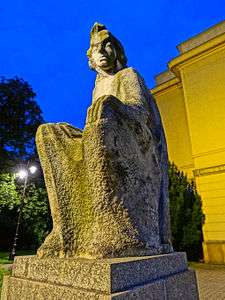 Chopin, Józef Makowski
Chopin, Józef Makowski Paderewski, Józef Makowski
Paderewski, Józef Makowski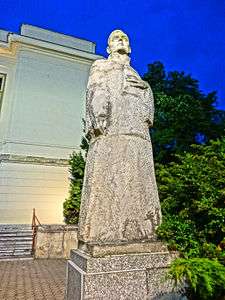 Szymanowski, Ewelina & Henryk Szczech-Siwicka
Szymanowski, Ewelina & Henryk Szczech-Siwicka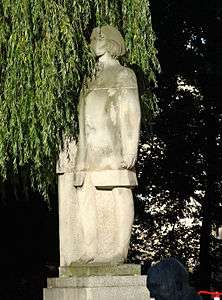 Wieniawski, Ewelina & Henryk Szczech-Siwicka
Wieniawski, Ewelina & Henryk Szczech-Siwicka Bacewicz, Ewelina & Henryk Szczech-Siwicka
Bacewicz, Ewelina & Henryk Szczech-Siwicka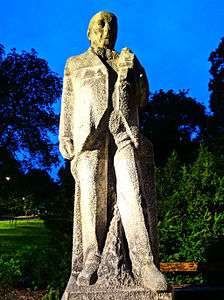 Moniuszko, Witold Marciniak
Moniuszko, Witold Marciniak Karłowicz, Henryk Rasmus
Karłowicz, Henryk Rasmus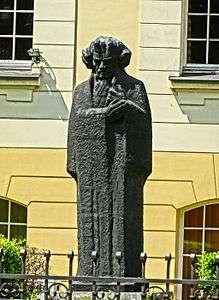 Beethoven, Witold Marciniak
Beethoven, Witold Marciniak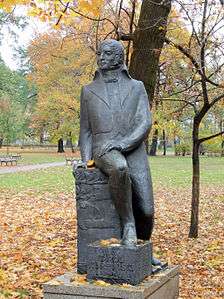 Kurpiński, Ewelina & Henryk Szczech-Siwicka
Kurpiński, Ewelina & Henryk Szczech-Siwicka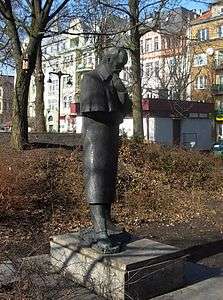 Tchaikovsky, Ewelina & Henryk Szczech-Siwicka
Tchaikovsky, Ewelina & Henryk Szczech-Siwicka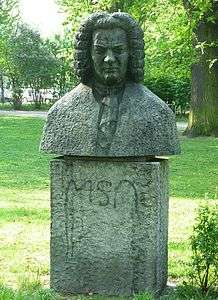 Johann Sebastian Bach, Witold Marciniak
Johann Sebastian Bach, Witold Marciniak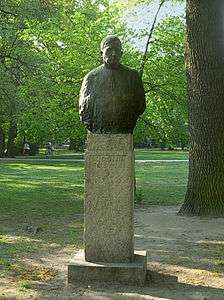 Różycki, Mieczysław Welter
Różycki, Mieczysław Welter Dvořák, Witold Marciniak
Dvořák, Witold Marciniak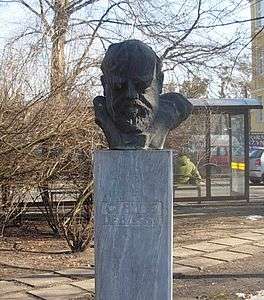 Debussy, Andrzej Kasten
Debussy, Andrzej Kasten Stravinsky, Barbara Zbrożyna
Stravinsky, Barbara Zbrożyna Henryk Mikołaj Górecki, Ryszard Wojciechowski
Henryk Mikołaj Górecki, Ryszard Wojciechowski
Species
The park displays a mix of native species (oak, hornbeam, beech tree, sycamore) and alien species (red beech and white horse chestnut). Moreover, one can notice red horse-chestnuts and European beeches (purple variety and cone variety)[11]
Nearby the Pomeranian Philharmonic building stand red horse-chestnuts and umbrella hornbeam. In the same way, abutting the Main building of Bydgoszcz Music Academy grow silver maples, a large English oaks and rare conifer species (Douglas-fir, eastern white pine and savin juniper).[11]
In the park are registered 21 species, making it the second most rich park in Bydgoszcz, with regards to vegetal variety.
Polish Natural Monuments in Jan Kochanowski Park and its surroundings[12][13]
| Nr | Type | Location | Nr of trees | Notes |
| 1. | Italian alder[14] | Southern portion of the park | 2 | Trunks diameters: 172 and 145 cm |
| 2. | Black poplar[15] | Centre of the park | 2 | Trunk diameter: 421 and 510 cm |
| 3. | English oak[15] | Centre of the park | 2 | Trunks diameters: 322 and 344 cm |
| 4. | Red horse-chestnut[16] | Around the Pomeranian Philharmonic building | 6 | Trunk diameter: from 170 to 234 cm |
| 5. | English hawthorn[15] | At Kołłątaja street 4 | 1 | Trunk diameter: 176 cm |
| 6. | English oak[17] | Centre of the park | 2 | |
| 7 | English oak[17] | All through the park | 6 | Trunks diameters: from 270 to 312 cm |
 Italian alder
Italian alder English Oak
English Oak Hawthorn
Hawthorn
Gallery
 Children playground with outdoor music instruments
Children playground with outdoor music instruments "The Archer" by night
"The Archer" by night In winter, the Polish Theatre in the background
In winter, the Polish Theatre in the background Bust of Bach with the Copernicanum building
Bust of Bach with the Copernicanum building Bust of Debussy with Ignacego Paderewskiego street in the backdrop
Bust of Debussy with Ignacego Paderewskiego street in the backdrop- View on Pomeranian Philarmonic building
 View of the park in Summer
View of the park in Summer
See also
| Wikimedia Commons has media related to Jan Kochanowski Park in Bydgoszcz. |
References
- 1 2 3 4 5 Kuczma, Rajmund (1995). Zieleń w dawnej Bydgoszczy. Bydgoszcz: Instytut Wydawniczy „Świadectwo”.
- ↑ Umiński, Janusz (1996). Bydgoszcz. Przewodnik. Bydgoszcz: Regionalny Oddział PTTK „Szlak Brdy”. ISBN 8390528207.
- ↑ opr., woj (14 April 2014). "Ten park stanie się wizytówką Bydgoszczy". bydgoszcz.wyborcza.pl. bydgoszcz.wyborcza. Retrieved 19 March 2017.
- 1 2 Sanger, Ireneusz (13 August 2015). "Park Jana Kochanowskiego w Bydgoszczy otwarty". radiopik.pl. Radio PiK SA. Retrieved 19 March 2017.
- ↑ mc (13 August 2015). "Wyremontowany park Jana Kochanowskiego już otwarty". bydgoszcz.wyborcza.pl. bydgoszcz.wyborcza. Retrieved 19 March 2017.
- ↑ Marta Leszczyńska, Wojciech Bielawa (19 August 2015). "Nowe instrumenty ozdobą parku. Tylko, jak na nich grać? Sprawdź". bydgoszcz.wyborcza.pl. bydgoszcz.wyborcza. Retrieved 19 March 2017.
- ↑ "Światła, muzyka i woda. Tańcząca fontanna wciąż przyciąga widownię". bydgoszcz.naszemiasto.pl. bydgoszcz.naszemiasto. 27 February 2017. Retrieved 12 March 2017.
- ↑ Maps of Bromberg (1914, 1941) and Bydgoszcz (1921, 1947)
- ↑ "Green Bydgoszcz". visitbydgoszcz.pl. Bydgoskie Centrum Informacji. 2017. Retrieved 19 March 2017.
- ↑ Gliwiński, Eugeniusz (1998). Bydgoskie pomniki naszych czasów cz. 2. Kalendarz Bydgoski. Bydgoszcz: Towarzystwo Miłośników Miasta Bydgoszczy. p. 95.
- 1 2 Mokra, Jolanta (1996). Zieleń miejska. Bydgoszcz: Bydgoska Gospodarka Komunalna. ISBN 83-85860-37-1.
- ↑ Rozporządzenie Nr 11/91 Wojewody Bydgoskiego z dn. 01.07.1991
- ↑ Measures from 2011
- ↑ Rozporządzenie nr 305/93 Wojewody Bydgoskiego z dnia 26 października 1993 roku
- 1 2 3 Rozporządzenie nr 18/92 Wojewody Bydgoskiego z dnia 8 czerwca 1992 roku
- ↑ Rozporządzenie Nr 13/97 Wojewody Bydgoskiego z dnia 14 lutego 1997 roku
- 1 2 "Uchwała nr XV/258/11 Rady Miasta Bydgoszcz z dnia 28 września 2011 roku" (PDF).
Bibliography
- (in Polish) Bydgoska Gospodarka Komunalna. Praca zbiorowa. Bydgoszcz 1996. ISBN 83-85860-37-1
- (in Polish) Kaja Renata. Bydgoskie pomniki przyrody. Instytut Wydawniczy „Świadectwo”. Bydgoszcz 1995. ISBN 83-85860-32-0
- (in Polish) Kuczma Rajmund. Zieleń w dawnej Bydgoszczy. Instytut Wydawniczy „Świadectwo”. Bydgoszcz 1995
- (in Polish) Umiński, Janusz: Bydgoszcz. Przewodnik, Regionalny Oddział PTTK „Szlak Brdy” Bydgoszcz 1996
